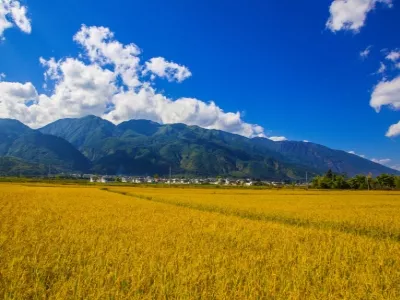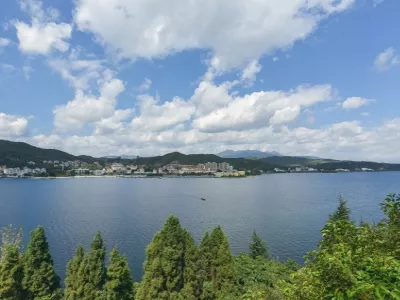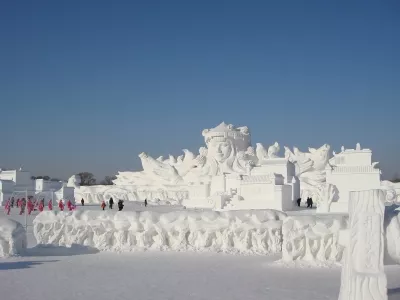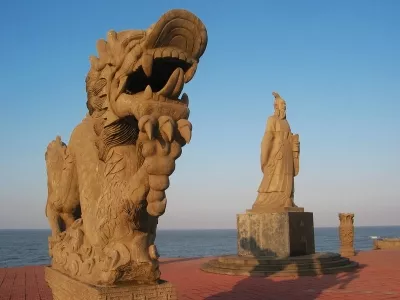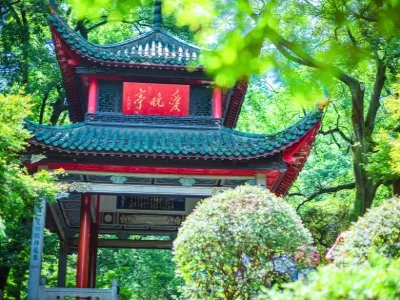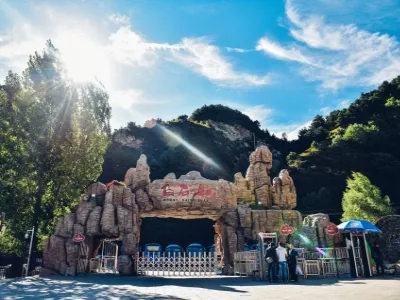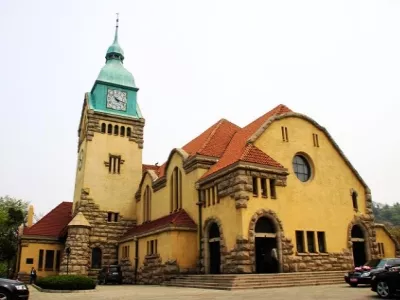Wenshan Zhuang and Miao Autonomous Prefecture lies in southeast Yunnan, bordering Guangxi to the east, Vietnam to the south, Honghe to the west, and Qujing to the north. The prefectural capital Wenshan City oversees 7 counties: Wenshan, Yanshan, Xichou, Maguan, Malipo, Qiubei, and Guangnan.
Stepping into Wenshan feels like entering a utopia where water is the soul of the landscape. Karst limestone formations, peaks, and dense forests intersect with meandering rivers to create spellbinding scenery.
Glide across crystal lakes, gather lotus blossoms in summer paddies, or lose yourself in idyllic rural vistas. Experience the vibrant folk customs of ethnic minorities, feast on colorful rice cooked in bamboo, and wander vast grasslands.
Wenshan's beauty defies description - you have to be there to fully appreciate it! The landscapes, cultures, and colors come together in a symphony that captures the essence of this border region.
Huamian Festival
The Huadian Festival is the most important traditional celebration of the Yi ethnic minority in Qubie County, Wenshan. Originating from ancient beliefs that smearing faces black with stove smoke warded off evil, young Yi men and women now use the festival to find love interests. On the festive day, determined by the first Snake or Pig day in the lunar February, participants chase one another and smudge black ash on faces to signify affection. The messier the face, the deeper the feelings. If uninterested, one flees to avoid being marked and reject the courtship. Now made with aromatic grass and spice ash, the playful facials draw tens of thousands each year. Locals still believe the blacker the face from others' affectionate grazes, the greater fortune and joy to come. Visitors can witness the spirited merriment and gain insight into Yi heritage and courtship. With playful yet meaningful rituals, the Huadian Festival offers a window into Yi culture.
Jumping Palace Festival
The Tiaogong Festival is a traditional celebration of ancestor worship and bamboo offerings observed by the Yi people. On the 8th day of the 4th lunar month or in June, Yi women, led by village chiefs, gather in festive attire at bamboo groves outside their villages. They burn incense, chant scriptures and make offerings to pay respect to ancestors and bamboo deities. Afterwards, there are festivities including singing, dancing, flute playing and more over the 3-day celebration. Mainly observed in Funing and Napo counties in Wenshan, Guangxi, the Tiaogong Festival offers visitors a window into Yi customs. They can watch elaborately dressed Yi women performing rituals, join in spirited public festivities and appreciate the Yi people's deep spiritual connection with ancestors and nature. By honoring traditions while celebrating the present, the Tiaogong Festival provides an immersive experience of enduring Yi ethnic culture.
Huashan Festival
The Huashan Festival, also known as “Stepping on Flower Mountain”, is a traditional festival of the Miao ethnic group held mainly in the Zhehei Scenic Area in Qubie County, Wenshan. Originating from ancestor worship of the Miao deity Chiyou, today’s Huashan Festival has evolved into a diverse celebration. On the 2nd to the 5th day of the first lunar month, Miao people dressed in colorful costumes sing love songs to each other under bright parasols to express affection. Other highlights include the flower pole worship ceremony, climbing flower poles, lu sheng courtship dances, bullfighting, martial arts performances, and more, bringing the festivities to an exciting climax. Visitors can appreciate the rich traditions of the Miao through their ornate costumes, courtship rituals, folk dances, and ethnic cuisine. The Huashan Festival offers an immersive experience into Miao history and culture in Wenshan.
Longduan Festival
The Longduan Festival, also known as “Flower Street”, is a traditional celebration of the Zhuang people in Guangnan and Funing counties in Wenshan, Yunnan. In the Zhuang language, “Longduan” means going to a broad, flat place. The festival is considered the “Valentine’s Day” of the Zhuang minority and also honors the birthday of the Taoist deity Zhenwu. On the festival day from the 25th to the 28th of the 3rd lunar month, Zhuang people from various villages gather together. Young men and women engage in courtship rituals like singing antiphonal love songs and performing Zhuang opera. Locals also exchange livestock, agricultural products and handicrafts in lively trading. Visitors can experience Zhuang customs by watching eclectic performances, trying Zhuang cuisine, and bargaining in local markets. With its vibrant mix of courtship, commerce and faith, Longduan provides an authentic glimpse into Zhuang ethnic culture.
Zhuang Dragon Festival
The Dragon Worship Festival is celebrated by many Chinese ethnic minorities, though each group observes it on different dates, usually the 3rd day of the 2nd, 3rd or 6th lunar month. On the 3rd day of the 3rd month, the Zhuang people of Nahong Village in Qubie County, Wenshan hold their version of the festival. On this day, Zhuang villagers perform rituals to venerate the Dragon God. Some villages staged dances with dragon costumes during the celebrations. As the symbolic dragon passes by their homes, locals splash water on it to bring good fortune and rainfall. Additional festivities include diverse cultural performances and activities. Visiting during the Zhuang Dragon Worship Festival, travelers can witness sacred traditions like dragon dancing, water sprinkling rituals, and enjoy the festive atmosphere. They gain insight into the Zhuang culture's deep roots in animism and reverence for nature. The festival offers an immersive experience of the Zhuang minority's spiritual beliefs and ethnic heritage.
King Pan Festival
The Panwang Festival is a traditional celebration observed by the Yao people, mainly in Dongpo Township, Funing County, Wenshan. During the festival on the 14th day of the 9th lunar month, Yao villagers slaughter livestock and host feasts to treat friends and family, exchanging well-wishes. Typically lasting 3 to 7 days, the Panwang Festival features performances of traditional Yao dance. Visitors can experience Yao culture through elaborate rituals, savoring Yao cuisine, and watching captivating dances with swirling costumes and sinuous movements. They may also join in the festivities by trying ethnic handicrafts and clothes. With its warm hospitality and vibrant rituals, the Panwang Festival offers an intimate look at enduring Yao heritage. It provides opportunities to bond over shared joy while gaining insight into a minority culture.
Best Travel Time
April to September is the best time for tourism in Wenshan, especially around May each year. The lotus flowers bloom in the Puzhehei Scenic Area of Wenshan, and the scenery is extremely beautiful. However, this is also the rainy season in Wenshan, so it is best to bring rain gear when going out.Dressing Guidelines
With average annual temperatures around 15.5-19.3°C, Wenshan sees its rainy season from May through September. Pack rain gear like foldable ponchos and umbrellas to stay dry when showers strike. The abundant mist and fog also brings dampness, making water-resistant outer layers a smart choice. As mornings and nights cool considerably from the daytime highs, bring extra layers like sweaters and jackets to stay warm.
Check forecasts and dress in moisture-wicking fabrics to readily handle Wenshan's weather fluctuations. Breathable shirts and lightweight, ventilated pants will keep you comfortable amid temperature swings. Sturdy, broken-in shoes ready you for hiking the verdant mountains and exploring magnificent caves. With the right balance of weather protection and adaptable garments, you'll be equipped to appreciate Wenshan's natural splendor while remaining cozy despite the variable climate.

